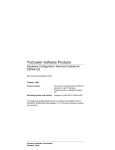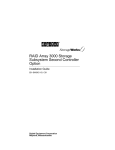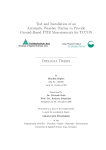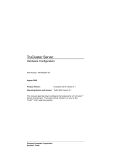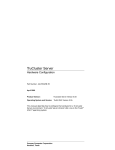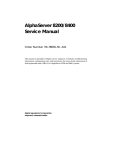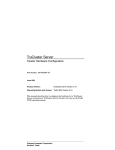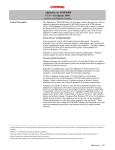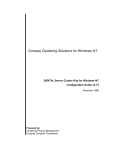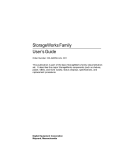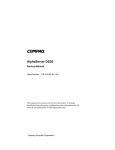Download Compaq RAID Array 3000 Controller Shelf User`s guide
Transcript
TruCluster Software Products Hardware Configuration Technical Update for StorageWorks RAID Array 3000 January 1999 Product Version: TruCluster Production Server Software Version 1.5 and TruCluster Available Server Software Version 1.5 Operating System and Version: Compaq’s DIGITAL UNIX Version 4.0D This technical update describes how to configure the hardware for the TruCluster Production Server Software Version 1.5 and TruCluster Available Server Software Version 1.5 products with a StorageWorks RAID Array 3000 storage subsystem. Compaq Computer Corporation Houston, Texas © Compaq Computer Corporation 1999 All rights reserved. The following are trademarks of Compaq Computer Corporation: ALL–IN–1, Alpha AXP, AlphaGeneration, AlphaServer, AltaVista, ATMworks, AXP, Bookreader, CDA, DDIS, DEC, DEC Ada, DEC Fortran, DEC FUSE, DECnet, DECstation, DECsystem, DECterm, DECUS, DECwindows, DTIF, Massbus, MicroVAX, OpenVMS, POLYCENTER, PrintServer, Q–bus, StorageWorks, Tru64, TruCluster, ULTRIX, ULTRIX Mail Connection, ULTRIX Worksystem Software, UNIBUS, VAX, VAXstation, VMS, XUI, and the Compaq logo. Microsoft, Windows, and Windows NT are registered trademarks of Microsoft Corporation. UNIX is a registered trademark and The Open Group is a trademark of The Open Group in the US and other countries. Restricted Rights: Use, duplication, or disclosure by the U.S. Government is subject to restrictions as set forth in subparagraph (c) (1) (ii). Compaq Computer Corporation makes no representations that the use of its products in the manner described in this publication will not infringe on existing or future patent rights, nor do the descriptions contained in this publication imply the granting of licenses to make, use, or sell equipment or software in accordance with the description. Possession, use, or copying of the software described in this publication is authorized only pursuant to a valid written license from Compaq or an authorized sublicensor. Compaq conducts its business in a manner that conserves the environment and protects the safety and health of its employees, customers, and the community. Contents About This Technical Update 1 Introducing the StorageWorks RAID Array 3000 Storage Subsystem 1.1 1.2 StorageWorks RAID Array 3000 General Overview .. . .. . .. . .. . RAID Array 3000 Restrictions .. . .. . .. . .. . . .. . .. . .. . .. . . .. . .. . .. . .. . 1–1 1–2 2 Using the StorageWorks RAID Array 3000 in a TruCluster Configuration 2.1 2.2 RA3000 Installation Overview . . .. . .. . .. . . .. . .. . .. . .. . . .. . .. . .. . .. . Installing and Configuring a TruCluster Configuration with a StorageWorks RAID Array 3000 .. . .. . .. . . .. . .. . .. . .. . . .. . .. . .. . .. . 2.2.1 Obtaining the Firmware Release Notes .. . .. . .. . . .. . .. . .. . .. . 2.2.2 KZPBA-CB Termination Resistors . . . .. . .. . .. . .. . . .. . .. . .. . .. . 2.2.3 Displaying KZPBA-CB Adapters with the show Console Commands . . .. . .. . .. . .. . . .. . .. . .. . .. . .. . . .. . .. . .. . .. . . .. . .. . .. . .. . 2.2.4 Displaying Console Environment Variables and Setting the KZPBA-CB SCSI ID . . .. . .. . .. . .. . . .. . .. . .. . .. . . .. . .. . .. . .. . 2.2.4.1 Displaying KZPBA-CB pk* or isp* Console Environment Variables . . .. . .. . .. . . .. . .. . .. . .. . . .. . .. . .. . .. . 2.2.4.2 Setting the KZPBA-CB SCSI ID .. . .. . .. . .. . . .. . .. . .. . .. . 2.2.5 Cabling Illustrations . . . .. . .. . .. . .. . .. . . .. . .. . .. . .. . . .. . .. . .. . .. . 2–1 2–3 2–9 2–10 2–10 2–14 2–14 2–17 2–17 3 Reconfiguring the RA3000 Pedestal for the Expansion Pedestal Option 3.1 3.2 Overview . . .. . .. . . .. . .. . .. . .. . . .. . .. . .. . .. . .. . . .. . .. . .. . .. . . .. . .. . .. . .. . Reconfiguring the RA3000 Base Pedestal UltraSCSI Bus . . .. . 3–1 3–2 Examples 2–1 2–2 2–3 2–4 Displaying Displaying Displaying Displaying Configuration on an AlphaServer Configuration on an AlphaServer Devices on an AlphaServer 4100 Devices on an AlphaServer 8200 4100 . .. . .. . .. . .. . 8200 . .. . .. . .. . .. . . .. . .. . . .. . .. . .. . .. . . .. . .. . . .. . .. . .. . .. . 2–11 2–11 2–12 2–13 Contents iii 2–5 2–6 2–7 Displaying the pk* Console Environment Variables on an AlphaServer 4100 System . . .. . .. . .. . .. . .. . . .. . .. . .. . .. . . .. . .. . .. . .. . Displaying Console Variables for a KZPBA-CB on an AlphaServer 8x00 System . . .. . .. . .. . .. . .. . . .. . .. . .. . .. . . .. . .. . .. . .. . Setting the SCSI Bus ID . . . .. . .. . .. . .. . .. . . .. . .. . .. . .. . . .. . .. . .. . .. . 2–15 2–16 2–17 Figures 2–1 2–2 2–3 2–4 2–5 2–6 2–7 2–8 2–9 2–10 2–11 2–12 3–1 3–2 3–3 KZPBA-CB Termination Resistors . .. . .. . . .. . .. . .. . .. . . .. . .. . .. . .. . StorageWorks RAID Array 3000 Controller Shelf Front View RAID Array 3000 Pedestal Rear View . . . .. . .. . .. . .. . . .. . .. . .. . .. . TruCluster Configuration with an RA3000 Controller Shelf with Active/Passive Failover and a DWZZH-05 UltraSCSI Hub . . . .. . .. . .. . .. . . .. . .. . .. . .. . . .. . .. . .. . .. . .. . . .. . .. . .. . .. . . .. . .. . .. . .. . TruCluster Configuration with an RA3000 Pedestal with Active/Passive Failover and a DWZZH-05 UltraSCSI Hub .. . TruCluster Configuration with an RA3000 Pedestal with Active/Passive Failover and a DWZZH-03 UltraSCSI Hub .. . TruCluster Configuration with an RA3000 Controller Shelf with Active/Active or Active/Passive Failover and a DWZZH-05 UltraSCSI Hub .. . .. . .. . .. . .. . . .. . .. . .. . .. . . .. . .. . .. . .. . TruCluster Configuration with an RA3000 Pedestal with Active/Active or Active/Passive Failover and a DWZZH-05 UltraSCSI Hub . . .. . .. . .. . .. . . .. . .. . .. . .. . .. . . .. . .. . .. . .. . . .. . .. . .. . .. . Externally Terminated TruCluster Configuration with an RA3000 Pedestal with Active/Passive Failover . . .. . . .. . .. . .. . .. . Externally Terminated TruCluster Configuration with an RA3000 Controller Shelf with Active/Passive Failover . . .. . .. . Externally Terminated TruCluster Configuration with an RA3000 Controller Shelf with Active/Active or Active/Passive Failover . .. . .. . .. . . .. . .. . .. . .. . . .. . .. . .. . .. . .. . . .. . .. . .. . .. . . .. . .. . .. . .. . Externally Terminated TruCluster Configuration with a Mid-bus RA3000 Controller Shelf with Active/Active or Active/Passive Failover . .. . . .. . .. . .. . .. . .. . . .. . .. . .. . .. . . .. . .. . .. . .. . RA3000 Pedestal Cabled for Split-Bus Configuration . .. . .. . .. . RA3000 Pedestal Cabled for Single-Bus Configuration . . .. . .. . RA3000 Pedestal SCSI ID Renumbering .. . .. . .. . .. . . .. . .. . .. . .. . 2–10 2–18 2–19 2–20 2–21 2–22 2–23 2–25 2–26 2–26 2–27 2–28 3–3 3–4 3–5 Tables 2–1 2–2 iv Contents Configuring TruCluster Hardware for Use with the RA3000 . Installing Cables for RA3000 Radial Configuration with a DWZZH UltraSCSI Hub .. . . .. . .. . .. . .. . .. . . .. . .. . .. . .. . . .. . .. . .. . .. . 2–4 2–6 2–3 Installing Cables for RA3000 Configuration Using External Termination and Y Cables . .. . .. . .. . .. . .. . . .. . .. . .. . .. . . .. . .. . .. . .. . 2–7 2–4 Hardware Components Used in the Configurations Shown in Figure 2–4, Figure 2–5, and Figure 2–6 . .. . .. . .. . .. . . .. . .. . .. . .. . 2–22 2–5 Hardware Components Used in the Configuration Shown in Figure 2–7 .. . .. . . .. . .. . .. . .. . . .. . .. . .. . .. . .. . . .. . .. . .. . .. . . .. . .. . .. . .. . 2–24 Hardware Components Used in the Configuration Shown in Figure 2–8 .. . .. . . .. . .. . .. . .. . . .. . .. . .. . .. . .. . . .. . .. . .. . .. . . .. . .. . .. . .. . 2–25 Hardware Components Used in the Configurations Shown in Figure 2–9 and Figure 2–10 . . .. . .. . .. . .. . . .. . .. . .. . .. . . .. . .. . .. . .. . 2–26 Hardware Components Used in the Configuration Shown in Figure 2–11 . . .. . . .. . .. . .. . .. . . .. . .. . .. . .. . .. . . .. . .. . .. . .. . . .. . .. . .. . .. . 2–27 Hardware Components Used in the Configuration Shown in Figure 2–12 . . .. . . .. . .. . .. . .. . . .. . .. . .. . .. . .. . . .. . .. . .. . .. . . .. . .. . .. . .. . 2–28 2–6 2–7 2–8 2–9 Contents v About This Technical Update This technical update provides important information about using the StorageWorks RAID Array 3000 (RA3000) with the TruCluster Production Server Software Version 1.5 and TruCluster Available Server Software Version 1.5 products. Audience If your plans to configure the hardware for TruCluster Production Server Software Version 1.5 or TruCluster Available Server Software Version 1.5 include a StorageWorks RAID Array 3000 (RA3000) storage subsystem, read this addendum to the TruCluster Software Products Hardware Configuration manual. Organization This technical update contains: • An introductory chapter • A chapter covering the configuration of the TruCluster Production Server Software Version 1.5 and TruCluster Available Server Software Version 1.5 products using a StorageWorks RAID Array 3000 storage subsystem • A chapter covering the cable reconfiguration necessary within the RA3000 pedestal when the expansion pedestal option is added About This Technical Update vii 1 Introducing the StorageWorks RAID Array 3000 Storage Subsystem This technical update to the TruCluster Software Products Hardware Configuration manual provides important information about support for the StorageWorks RAID Array 3000 (RA3000) with the TruCluster Production Server Software and TruCluster Available Server Software Version 1.5 products. 1.1 StorageWorks RAID Array 3000 General Overview The StorageWorks RAID Array 3000 (RA3000) is a low-end, standalone UltraSCSI RAID subsystem that incorporates the latest in RAID technology. It supports RAID levels 0, 1, 0+1, 4, 5, and JBOD disks. The RA3000 storage subsystem has fully redundant components to eliminate single points of failure. It comes with a standard uninterruptible power supply (UPS) for cache data protection during power outages. The RA3000 uses the dual-ported HSZ22 controller. Optional dual redundant controllers with mirrored write-back cache provide maximum data integrity. The StorageWorks Command Console (SWCC) V2.0 (or higher) client graphical user interface (GUI) runs on a Microsoft® Windows® 95 or Windows NT® PC connected directly to the RA3000 by a serial line. After the first virtual disk has been created, you can also communicate with your RAID Array 3000 over a TCP/IP network provided the V2.0 (or higher) SWCC Agent has been installed on the Digital UNIX member system. The RA3000 is available as: • DS-SWXRA-GH—A rackmount subsystem (standard RETMA or metric cabinet) containing a controller shelf with one HSZ22 controller, an uninterruptible power supply (UPS), two host I/O modules, a device I/O module, and one 6-slot device expansion shelf. Up to three additional expansion shelves (DS-SWXRA-GN) may be added to provide a maximum of 24 storage devices. • DS-SWXRA-GA—A deskside pedestal subsystem that includes one HSZ22 controller. The base pedestal accommodates up to seven storage Introducing the StorageWorks RAID Array 3000 Storage Subsystem 1–1 devices. The included battery backup subsystem is a free-standing UPS. An expansion pedestal option (DS-SWXRA-GD) increases the storage capacity of the subsystem to 14 storage devices. A second HSZ22 controller option (DS-HSZ22-AA) can be added to either RA3000 subsystem. 1.2 RAID Array 3000 Restrictions The following restrictions are imposed for initial support of the StorageWorks RAID Array 3000 (RA3000) subsystem on TruCluster Software Products: • The RA3000 is only supported on TruCluster Production Server Software Version 1.5 and TruCluster Available Server Software Version 1.5 with Compaq’s DIGITAL UNIX Version 4.0D after installation of the following operating system patch. The DIGITAL UNIX and TruCluster patches are included in one kit. – Compaq’s DIGITAL UNIX and TruCluster Patch Kit #3: DUV40DAS00003-19981208.tar (or later) The patch may be obtained from the Software Patch (ECO) Access Web site by selecting Browse Patch Tree at the following URL: http://www.service.digital.com/patches/ • The HSZ22 requires Version D11s firmware. • StorageWorks Command Console (SWCC) Revision 2.0 (or higher) is required. • The following member systems are supported: – AlphaServer 800 – AlphaServer 1000A – AlphaServer 1200 – AlphaServer 4x00 • The member systems require system SRM console firmware from the Alpha Systems Firmware 5.3 Update CD. • The KZPBA-CB UltraSCSI host adapter is the only SCSI bus host adapter supported with the RA3000 with the TruCluster products. The KZPBA-CB requires ISP 1020/1040 firmware Version 5.57, available with the system SRM console firmware on the Alpha Systems Firmware 5.3 Update CD. • The controller will not operate without at least one 16 MB SIMM installed in its cache. 1–2 Introducing the StorageWorks RAID Array 3000 Storage Subsystem • The device expansion shelf (DS-SWXRA-GN) for the rackmount version must be at revision level B01 or higher. • The DS-BA35X-FA single-ended personality module used in the DS-SWXRA-GN UltraSCSI storage expansion shelves must be at revision H01 or higher. Introducing the StorageWorks RAID Array 3000 Storage Subsystem 1–3 2 Using the StorageWorks RAID Array 3000 in a TruCluster Configuration This chapter describes how to install the hardware for a TruCluster Production Server Software or TruCluster Available Server Software configuration which includes the StorageWorks RAID Array 3000 (RA3000) storage subsystem. 2.1 RA3000 Installation Overview Review the restrictions in Section 1.2 before installing any TruCluster Production Server Software or TruCluster Available Server Software hardware. See the following TruCluster Software Products manuals for assistance in cluster configuration, installation, and administration: • Hardware Configuration—Describes how to set up the systems that are to become cluster members, and how to configure cluster shared storage. • Software Installation—Describes how to install TruCluster Software products. • Administration—Describes administration tasks, such as those required to set up an ASE. It also shows how to configure, start, and manage distributed raw disk (DRD) services and other available services. See the following TruCluster technical updates: • Hardware Configuration Technical Update for DS-DWZZH-03 UltraSCSI Hub • Hardware Configuration Technical Update for DS-DWZZH-05 UltraSCSI Hub • Hardware Configuration Technical Update for KZPBA-CB These technical updates may be obtained from the Web at the following URL: http://www.unix.digital.com/faqs/publications/pub_page/update_list.html See the following StorageWorks manuals for more information on the StorageWorks RAID Array 3000 or UltraSCSI configuration: Using the StorageWorks RAID Array 3000 in a TruCluster Configuration 2–1 • Command Console V2.0 for RAID Array 3000 User’s Guide (AA-RBF2A-TE)—A graphical user interface (GUI) for managing StorageWorks RAID products from a console running on a Windows 95 or Windows NT PC. • Getting Started RAID Array 3000 for Digital UNIX Installation Guide Describes how to unpack and set up your RA3000 subsystem components, how to prepare your host system for use with the RA3000, how to install the SWCC and create your first virtual disk, and how to communicate over a TCP/IP connection. • StorageWorks RAID Array 3000 Controller Shelf Hardware User’s Guide (EK-SMCPQ-UG)—Provides an overview and physical description and describes the major features and characteristics of the RA3000 rack mount subsystem. It also provides installation and cabling procedures. • RAID Array 3000 Storage Subsystem Hardware User’s Guide (EK-SMCPO-UG)—Provides an overview and physical description of the RA3000 pedestal subsystem and describes how to install the expansion pedestal option and how to convert the UltraSCSI bus in the base pedestal from a split-bus to a through-bus configuration. • RAID Array 3000 Storage Subsystem Second Controller Option Installation Guide (EK-SM3KC-IG)—Includes the steps required to install a second HSZ22 controller option in the pedestal or controller shelf enclosures. This includes saving the existing configuration using the StorageWorks Command Console (SWCC), unpgrading the firmware, and installing the cache memory SIMM modules to accommodate the second controller. • RAID Array 3000 Storage Subsystem Expansion Pedestal Option Installation Guide (EK-SM3KA-IG)—Describes how to install the expansion pedestal option and how to convert the UltraSCSI bus in the base pedestal from a split-bus to a through-bus configuration. The information in this guide is basically a reprint of Chapter 4 from the RAID Array 3000 Storage Subsystem Hardware User’s Guide. • UltraSCSI Configuration Guidelines (EK-ULTRA-CG)—Provides UltraSCSI configuration rules and describes UltraSCSI components. • StorageWorks Solutions BA356-SB 16-Bit Shelf User’s Guide (EK-BA356-UG)—Describes the major StorageWorks 16-bit components (such as shelves, power units, StorageWorks building blocks (SBBS) and SCSI buses, personality modules, and cables), status displays, specifications, and replacement procedures. • StorageWorks SBB Shelf I/O Modules User’s Guide (EK-SBBIO-UG)—Describes the 8-bit and 16-bit shelf I/O modules that can be used with the BA356-series 16-bit SBB storage shelves. 2–2 Using the StorageWorks RAID Array 3000 in a TruCluster Configuration The following sections describe how to install and configure the hardware for a TruCluster Production Server Software or TruCluster Available Server Software configuration that includes the StorageWorks RAID Array 3000 subsystem. 2.2 Installing and Configuring a TruCluster Configuration with a StorageWorks RAID Array 3000 This section provides details on how to install and configure the hardware to support the StorageWorks RAID Array 3000 (RA3000) in a TruCluster configuration. The qualification and use of the DS-DWZZH-series UltraSCSI hubs in TruCluster configurations allows the cluster to be cabled in two different ways: • Preferred method with radial connection to a DWZZH UltraSCSI hub and internal termination: The KZPBA-CB internal termination resistor SIPs are not removed. The host adapters are connected directly to a DWZZH UltraSCSI hub port. There can be only one member system or controller port connected to each hub port. The use of a DWZZH UltraSCSI hub in a TruCluster configuration is preferred because it: • – Improves the reliability of the detection of cable faults – Provides for automatic termination of the UltraSCSI bus upon a fault or cable removal – Is easier to cable the configuration, and therefore less prone to human error Old method with external termination: Shared SCSI bus termination is external to the KZPBA-CB UltraSCSI host adapter. This is the old method used to connect a PCI SCSI adapter to the cluster; remove the adapter termination resistor SIPs and install a BN21W-0B Y cable and an H879-AA terminator for external termination. This allows the removal of a SCSI bus cable from the host adapter without affecting SCSI bus termination. This method may be used with or without a DWZZH UltraSCSI hub with the following restrictions: – You may use external termination and Y cables with a DWZZH-03 UltraSCSI hub to achieve a 4-member cluster configuration. – You may not use external termination and Y cables with a DWZZH-05 UltraSCSI hub. Follow the steps in Table 2–1 to start the procedure to configure the hardware for a TruCluster Production Server or TruCluster Available Using the StorageWorks RAID Array 3000 in a TruCluster Configuration 2–3 Server configuration using an RA3000 storage subsystem. For TruCluster Available Server Software, skip the first step as you do not use Memory Channel. Also, you may save time by installing the Memory Channel adapters, redundant network adapters (if applicable), as well as the KZPBA-CB UltraSCSI host adapters all at the same time. Follow the directions in the referenced documentation, or the steps in the referenced sections and tables at each step, returning to Table 2–1 when you have completed the steps in the referenced section or table. Table 2–1: Configuring TruCluster Hardware for Use with the RA3000 Step Action Refer to: 1 TruCluster Software Products Hardware Configuration Chapter 5a 2 3 Power down the system and install the Memory Channel module(s), cables, and hub(s), if a hub is required. b Install network adapters if required to provide network failover for TruCluster Available Server Software. Install Ethernet or FDDI network adapters. User’s guide for the applicable Ethernet or FDDI adapter, and the user’s guide for the applicable system Install ATM adapters if using ATM. ATMworks 350 Adapter Installation and Service KZPBA-CB termination KZPBA-CB PCI-to-Ultra SCSI Differential Host Adapter User’s Guide The preferred method of radial connection to a DWZZH: Ensure that the eight KZPBA-CB internal termination resistor SIPs, RM1 - RM8, are installed Section 2.2.2 and Figure 2–1 Using external termination and Y cables: Section 2.2.2 and Figure 2–1 Remove the eight KZPBA-CB internal termination resistor SIPs, RM1 - RM8 4 Install the KZPBA-CB UltraSCSI host adapter in the PCI slot corresponding to the logical bus to be used for the shared SCSI bus. Ensure that the number of adapters are within limits for the system, and that the placement is acceptable. KZPBA-CB PCI-to-Ultra SCSI Differential Host Adapter User’s Guide 2–4 Using the StorageWorks RAID Array 3000 in a TruCluster Configuration Table 2–1: Configuring TruCluster Hardware for Use with the RA3000 (cont.) Step Action Refer to: 5 Power up the system and use the show Section 2.2.3 and config and show device console commands Example 2–1 through to display the installed devices and Example 2–4 information about the KZPBA-CBs on the AlphaServer systems. Look for QLogic ISP1020 in the show config display and isp in the show device display to determine which devices are KZPBA-CBs. 6 If necessary, update the SRM firmware. ______________________ Note Firmware release notes for the system (see Section 2.2.1) ______________________ The SRM console firmware includes the ISP1020/1040-based PCI option firmware, which includes the KZPBA-CB. When you update the SRM console firmware, you are enabling the KZPBA-CB firmware to be updated. On a power-up reset, the SRM console loads KZPBA-CB adapter firmware from the console system flash ROM into NVRAM for all Qlogic ISP1020/1040-based PCI options, including the KZPBA-CB PCI-to-Ultra SCSI adapter. 7 Use the show pk* or show isp* console Section 2.2.4 and commands to determine the KZPBA-CB SCSI Example 2–5 through bus ID, and then use the set console Example 2–7 command to set the SCSI bus ID. ______________________ Notes ______________________ Ensure that the SCSI ID that you use is distinct from all other SCSI IDs on the same shared SCSI bus. If you do not remember the other SCSI IDs, or do not have them recorded, you must determine these SCSI IDs. If you are using a DS-DWZZH-05, you cannot use SCSI ID 7 for a member systems’ host adapter; SCSI ID 7 is reserved for DS-DWZZH-05 use. If you are using a DS-DWZZH-05 and fair arbitration is enabled, you must use the SCSI ID assigned to the hub port the adapter will be connected to. You will have problems if you have two or more SCSI adapters at the same SCSI ID on any one SCSI bus. 8 Repeat steps 1 through 7 for any other member systems. 9 Cable the member system to the RAID Array 3000 subsystem: Using the StorageWorks RAID Array 3000 in a TruCluster Configuration 2–5 Table 2–1: Configuring TruCluster Hardware for Use with the RA3000 (cont.) Step Action Refer to: The preferred method of radial connection to a DWZZH UltraSCSI hub Table 2–2 Using external termination and Y cables Table 2–3 aSkip this step for the TruCluster Available Server Software product. bIf you install additional PCI adapters or an extra network adapter at this time, delay testing the Memory Channel adapter(s) until you have installed all hardware. Table 2–2 provides the steps necessary to connect the member systems to an RA3000 storage subsystem using radial connection to a DWZZH UltraSCSI hub. ______________________ Notes ______________________ All configuration illustrations assume that a second, redundant HSZ22 controller is installed to achieve active/active or active/passive failover. See the RA3000 documentation for information about configuring the storage devices. Table 2–2: Installing Cables for RA3000 Radial Configuration with a DWZZH UltraSCSI Hub Step Action 1 Install a BN38C HD68 to VHDCI cable between each KZPBA-CB UltraSCSI host adapter and a DWZZH port. The DWZZH accepts the VHDCI connector.a 2 Install BN37A cables:b Refer to: Figure 2–4 through Figure 2–7 Figure 2–2 and RA3000 controller shelf with active/passive failover: Install a BN37A cable between any Figure 2–4 DWZZH-03 port or the DWZZH-05 controller port and the RA3000 controller shelf Host 0 I/O module Host In port. RA3000 pedestal with active/passive failover: Figure 2–3 and Install a BN37A cable between any DWZZH-03 port or Figure 2–5 or the DWZZH-05 controller port and the RA3000 Figure 2–6 pedestal Host 0 port. 2–6 Using the StorageWorks RAID Array 3000 in a TruCluster Configuration Table 2–2: Installing Cables for RA3000 Radial Configuration with a DWZZH UltraSCSI Hub (cont.) Step Action Refer to: Figure 2–2 and RA3000 controller shelf with active/active or active/passive failover: Install a BN37A cable Figure 2–7 between any DWZZH-03 port or the DWZZH-05 controller port and the RA3000 controller shelf Host 0 I/O module Host In port. Install a BN37A-0E 0.5 meter cable between the Host 0 I/O module Host Out port and the Host 1 I/O module Host In port. RA3000 pedestal with active/active or Figure 2–3 and active/passive failover: Install a BN37A cable Figure 2–8 between the DWZZH-05 controller port and the RA3000 pedestal Host 0 port. Install a second BN37A cable between a DWZZH-05 host port and the RA3000 pedestal Host 1 port. ______________________ Note ______________________ If you connect a DWZZH-05 host port to an RA3000 pedestal host port to provide active/active failover, you must disable fair arbitration on the DWZZH-05 by placing the fair arbitration switch in the DISABLE position. aThe maximum length of the SCSI bus segment, including the BN38C cable and internal device length, must not exceed 25 meters. bThe maximum length of the SCSI bus segment, including the BN37A cables and internal device length, must not exceed 25 meters. Table 2–3 provides the steps necessary to connect the member systems to an RA3000 storage subsystem using external termination and Y cables. Table 2–3: Installing Cables for RA3000 Configuration Using External Termination and Y Cables Step Action Refer to: 1 Install a BN21W-0B Y cable on each KZPBA-CB UltraSCSI host adapter to be connected to the shared SCSI bus. Figure 2–9 through Figure 2–11 2 Install an H879-AA terminator on one leg of the Figure 2–9 through BN21W-0B Y cable of the member systems that will be Figure 2–11 on the end of the shared SCSI bus. The RA3000 controller shelf Host I/O module or pedestal provides active termination for the other end of the shared SCSI bus. 3 Install SCSI bus cables: Using the StorageWorks RAID Array 3000 in a TruCluster Configuration 2–7 Table 2–3: Installing Cables for RA3000 Configuration Using External Termination and Y Cables (cont.) Step Action Refer to: RA3000 pedestal with active/passive failover: Install a BN38C HD68 to VHDCI cable between the BN21W-0B Y cable of one member system and the RA3000 Host 0 port. Install a BN21K, BN21L, or BN31G cable between the BN21W-0B Y cables of all other member systems.a Figure 2–9 Figure 2–10 RA3000 controller shelf with active/passive failover: Install a BN38C HD68 to VHDCI cable between the BN21W-0B Y cable of one member system and the RA3000 Host 0 I/O module Host In connection. Install a BN21K, BN21L, or BN31G cable between the BN21W-0B Y cables of all other member systems.a RA3000 controller shelf with active/active or active/passive failover: Install a BN38C HD68 to VHDCI cable between the BN21W-0B Y cable of one member system and the RA3000 Host 0 I/O module Host In connection. Install a BN37A-0E 0.5-meter VHDCI cable between the RA3000 controller shelf Host 0 I/O module Host Out port and the Host 1 I/O module Host In port. Install a BN21K, BN21L, or BN31G cable between the BN21W-0B Y cables of all other member systems.b Figure 2–11 Figure 2–12 RA3000 mid-bus controller shelf with active/active or active/passive failover: Install a BN38C HD68 to VHDCI cable between the BN21W-0B Y cable of one member system and the RA3000 Host 0 I/O module Host In connection. Install a second BN38C HD68 to VHDCI cable between the BN21W-0B Y cable of another member system and the RA3000 Host 1 I/O module Host Out connection. This disables the termination on the Host 1 I/O module. Install a BN37A-0E 0.5-meter VHDCI cable between the RA3000 controller shelf Host 0 I/O module Host Out port and the Host 1 I/O module Host In port. The connection to Host 0 I/O module Host Out port disables the termination on that Host I/O module. Install a BN21K, BN21L, or BN31G cable between the BN21W-0B Y cables of any other member systems.c ______________________ Note ______________________ You cannot create a mid-bus configuration using a RA3000 pedestal. The member systems on one SCSI bus segment connected to the Host 0 port would see some devices. The member systems on the other SCSI bus segment connected to the Host 1 port would not be able to see the same devices. aThe maximum length of the SCSI bus segment, including the combined length of the BN38C and BN21K (or BN21L or BN31G) cables and internal device length, must not exceed 25 meters. bThe maximum length of the SCSI bus segment, including the combined length of the BN38C and BN37A cables and internal device length, must not exceed 25 meters. 2–8 Using the StorageWorks RAID Array 3000 in a TruCluster Configuration Table 2–3: Installing Cables for RA3000 Configuration Using External Termination and Y Cables (cont.) cThe maximum length of the SCSI bus segment, including the combined length of the BN38C, BN37A-0E, and BN21K (or BN21L or BN31G) cables and internal device length, must not exceed 25 meters. The following sections describe how to install a KZPBA-CB UltraSCSI PCI adapter in more detail. Section 2.2.5 provides illustrations of cluster configurations. 2.2.1 Obtaining the Firmware Release Notes You may be required to update the system or SCSI controller firmware during an Available Server or Production Server installation, so you may need the firmware release notes. Obtain the firmware release notes from the current Alpha Systems Firmware Update CD-ROM. _______________________ Note _______________________ To obtain the firmware release notes from the Firmware Update Utility CD-ROM, your kernel must be configured for the ISO 9660 Compact Disk File System (CDFS). To obtain the release notes for the firmware update follow these steps: 1. At the console prompt, or using the system startup log if the DIGITAL UNIX operating system is running, determine the drive number of the CD-ROM. 2. Boot the DIGITAL UNIX operating system if it is not already running. 3. Log in as root. 4. Place the Alpha Systems Firmware Update CD-ROM applicable to the DIGITAL UNIX version installed (or to be installed) into the drive. 5. Mount the CD-ROM as follows (/dev/rz4c is used as an example CD-ROM drive): # mount -rt cdfs -o noversion /dev/rz4c /mnt 6. Copy the appropriate release notes to your system disk. In this example, obtain the firmware release notes for the AlphaServer 4000/4100 from the Alpha Firmware Update 3.9 CD-ROM: # cp /mnt/doc/alpha4100_v48_fw_relnote.txt as4100-rel-notes 7. Unmount the CD-ROM drive. # umount /mnt Using the StorageWorks RAID Array 3000 in a TruCluster Configuration 2–9 8. Print the release notes. 2.2.2 KZPBA-CB Termination Resistors The KZPBA-CB internal termination is disabled by removing the termination resistors RM1 through RM8, as shown in Figure 2–1. Figure 2–1: KZPBA-CB Termination Resistors Internal Narrow Device Connector P2 Internal Wide Device Connector J2 JA1 SCSI Bus Termination Resistors RM1-RM8 ZK-1451U-AI 2.2.3 Displaying KZPBA-CB Adapters with the show Console Commands Use the show config and show device console commands to display system configuration. Use the output to determine which devices are KZPBA-CBs, and to determine their SCSI bus IDs. Example 2–1 shows the output from the show config console command on an AlphaServer 4100 system. 2–10 Using the StorageWorks RAID Array 3000 in a TruCluster Configuration Example 2–1: Displaying Configuration on an AlphaServer 4100 P00>>> show config Digital Equipment Corporation AlphaServer 4x00 Console V5.1-3 OpenVMS PALcode V1.1914, Digital UNIX PALcode V1.21-22 Module System Motherboard Memory 64 MB SYNC Memory 64 MB SYNC Memory 64 MB SYNC Memory 64 MB SYNC CPU (4MB Cache) CPU (4MB Cache) Bridge (IOD0/IOD1) PCI Motherboard Type 0 0 0 0 0 3 3 600 8 Rev 0000 0000 0000 0000 0000 0000 0000 0021 0000 Name mthrbrd0 mem0 mem1 mem2 mem3 cpu0 cpu1 iod0/iod1 saddle0 Bus 0 Slot 1 2 3 4 5 iod0 (PCI0) Option Name PCEB S3 Trio64/Trio32 DECchip 21040-AA DEC KZPSA DEC PCI MC Type 4828086 88115333 21011 81011 181011 Rev 0005 0000 0024 0000 000B Name pceb0 vga0 tulip0 pks1 mc0 Bus 1 Slot pceb0 (EISA Bridge connected to iod0, slot 1) Option Name Type Rev Name Bus 0 Slot 1 2 3 4 5 iod1 (PCI1) Option Name NCR 53C810 NCR 53C810 QLogic ISP1020 QLogic ISP1020 DEC KZPSA Type 11000 11000 10201077 10201077 81011 Rev 0002 0002 0005 0005 0000 Name ncr0 ncr1 isp0 isp1 pks0 Example 2–2 shows the output from the show config console command entered on an AlphaServer 8200 system. Example 2–2: Displaying Configuration on an AlphaServer 8200 >>> show config Name TLSB 4++ KN7CC-AB Type Rev 8014 0000 Mnemonic kn7cc-ab0 Using the StorageWorks RAID Array 3000 in a TruCluster Configuration 2–11 Example 2–2: Displaying Configuration on an AlphaServer 8200 (cont.) 5+ 8+ MS7CC KFTIA 5000 2020 0000 0000 ms7cc0 kftia0 C0 0+ 1+ 2+ 4+ 5+ 6+ Internal PCI connected to kftia0 pci0 QLogic ISP1020 10201077 0001 isp0 QLogic ISP1020 10201077 0001 isp1 DECchip 21040-AA 21011 0023 tulip0 QLogic ISP1020 10201077 0001 isp2 QLogic ISP1020 10201077 0001 isp3 DECchip 21040-AA 21011 0023 tulip1 C1 0+ 1+ 2+ 3+ 4+ 7+ PCI connected to kftia0 KZPAA 11000 QLogic ISP1020 10201077 KZPSA 81011 KZPSA 81011 KZPSA 81011 DEC PCI MC 181011 0001 0005 0000 0000 0000 000B kzpaa0 isp4 kzpsa0 kzpsa1 kzpsa2 mc0 Example 2–3 shows the output from the show device console command entered on an AlphaServer 4100 system. Example 2–3: Displaying Devices on an AlphaServer 4100 P00>>> show device polling ncr0 (NCR 53C810) slot 1, bus0 PCI, hose 1 SCSI Bus ID 7 dka500.5.0.1.1 Dka500 RRD45 1645 polling ncr1 (NCR 53C810) slot 2, bus0 PCI, hose 1 SCSI Bus ID 7 dkb0.0.0.2.1 DKb0 RZ29B 0007 dkb100.1.0.2.1 DKb100 RZ29B 0007 polling isp0 (QLogic ISP1020) slot 3, bus 0 PCI, hose 1 SCSI Bus ID 7 dkc0.0.0.3.1 DKc0 HSZ70 V70Z dkc1.0.0.3.1 DKc1 HSZ70 V70Z dkc2.0.0.3.1 DKc2 HSZ70 V70Z dkc3.0.0.3.1 DKc3 HSZ70 V70Z dkc4.4.0.3.1 DKc4 HSZ70 V70Z dkc5.0.0.3.1 DKc5 HSZ70 V70Z dkc6.0.0.3.1 DKc6 HSZ70 V70Z dkc100.1.0.3.1 DKc100 RZ28M 0568 dkc200.2.0.3.1 DKc200 RZ28M 0568 dkc300.3.0.3.1 DKc300 RZ28 442D polling isp1 (QLogic ISP1020) slot 4, bus 0 PCI, hose 1 SCSI Bus ID 7 dkd0.0.0.4.1 DKd0 HSZ50-AX X29Z dkd1.0.0.4.1 DKd1 HSZ50-AX X29Z dkd2.0.0.4.1 DKd2 HSZ50-AX X29Z dkd100.1.0.4.1 DKd100 RZ26N 0568 dkd200.1.0.4.1 DKd200 RZ26 392A dkd300.1.0.4.1 DKd300 RZ26N 0568 polling kzpsa0 (DEC KZPSA) slot 5, bus 0 PCI, hose 1 TPwr 1 Fast 1 Bus ID 7 kzpsa0.7.0.5.1 dke TPwr 1 Fast 1 Bus ID 7 L01 A11 dke100.1.0.5.1 DKe100 RZ28 442D 2–12 Using the StorageWorks RAID Array 3000 in a TruCluster Configuration Example 2–3: Displaying Devices on an AlphaServer 4100 (cont.) dke200.2.0.5.1 DKe200 RZ26 392A dke300.3.0.5.1 DKe300 RZ26L 442D polling floppy0 (FLOPPY) pceb IBUS hose 0 dva0.0.0.1000.0 DVA0 RX23 polling kzpsa1 (DEC KZPSA) slot 4, bus 0 PCI, hose 0 TPwr 1 Fast 1 Bus ID 7 kzpsa1.7.0.4.1 dkf TPwr 1 Fast 1 Bus ID 7 E01 A11 dkf100.1.0.5.1 DKf100 RZ26 392A dkf200.2.0.5.1 DKf200 RZ28 442D dkf300.3.0.5.1 DKf300 RZ26 392A polling tulip0 (DECchip 21040-AA) slot 3, bus 0 PCI, hose 0 ewa0.0.0.3.0 00-00-F8-21-0B-56 Twisted-Pair Example 2–4 shows the output from the show device console command entered on an AlphaServer 8200 system. Example 2–4: Displaying Devices on an AlphaServer 8200 >>> show device polling for units polling for units polling for units polling for units polling for units pke0.7.0.0.1 dke0.0.0.0.1 dke200.2.0.0.1 dke400.4.0.0.1 on isp0, slot0, bus0, hose0... on isp1, slot1, bus0, hose0... on isp2, slot4, bus0, hose0... on isp3, slot5, bus0, hose0... kzpaa0, slot0, bus0, hose1... kzpaa4 SCSI Bus ID 7 DKE0 RZ28 442D DKE200 RZ28 442D DKE400 RRD43 0064 polling for units dkf0.0.0.1.1 dkf1.0.0.1.1 dkf2.0.0.1.1 dkf3.0.0.1.1 dkf4.0.0.1.1 dkf5.0.0.1.1 dkf6.0.0.1.1 dkf100.1.0.1.1 dkf200.2.0.1.1 dkf300.3.0.1.1 isp4, slot1, bus0, hose1... DKF0 HSZ70 DKF1 HSZ70 DKF2 HSZ70 DKF3 HSZ70 DKF4 HSZ70 DKF5 HSZ70 DKF6 HSZ70 DKF100 RZ28M DKF200 RZ28M DKF300 RZ28 polling for units kzpsa0.4.0.2.1 dkg0.0.0.2.1 dkg1.0.0.2.1 dkg2.0.0.2.1 dkg100.1.0.2.1 dkg200.2.0.2.1 on kzpsa0, slot 2, bus 0, hose1... dkg TPwr 1 Fast 1 Bus ID 7 L01 A11 DKG0 HSZ50-AX X29Z DKG1 HSZ50-AX X29Z DKG2 HSZ50-AX X29Z DKG100 RZ26N 0568 DKG200 RZ28 392A V70Z V70Z V70Z V70Z V70Z V70Z V70Z 0568 0568 442D Using the StorageWorks RAID Array 3000 in a TruCluster Configuration 2–13 Example 2–4: Displaying Devices on an AlphaServer 8200 (cont.) dkg300.3.0.2.1 DKG300 RZ26N 0568 polling for units kzpsa1.4.0.3.1 dkh100.1.0.3.1 dkh200.2.0.3.1 dkh300.3.0.3.1 on kzpsa1, slot 3, bus 0, hose1... dkh TPwr 1 Fast 1 Bus ID 7 L01 A11 DKH100 RZ28 442D DKH200 RZ26 392A DKH300 RZ26L 442D polling for units kzpsa2.4.0.4.1 dki100.1.0.3.1 dki200.2.0.3.1 dki300.3.0.3.1 on kzpsa2, slot 4, bus 0, hose1... dki TPwr 1 Fast 1 Bus ID 7 L01 A10 DKI100 RZ26 392A DKI200 RZ28 442C DKI300 RZ26 392A 2.2.4 Displaying Console Environment Variables and Setting the KZPBA-CB SCSI ID The following sections show how to use the show console command to display the pk* and isp* console environment variables and set the KZPBA-CB SCSI ID on various AlphaServer systems. Use these examples as guides for your system. Note that the console environment variables used for the SCSI options vary from system to system. Also, a class of environment variables (for example, pk* or isp*) may show both internal and external options. Compare the following examples with the devices shown in the show config and show dev examples to determine which devices are KZPBA-CBs on the shared SCSI bus. 2.2.4.1 Displaying KZPBA-CB pk* or isp* Console Environment Variables To determine the console environment variables to use, execute the show pk* and show isp* console commands. Example 2–5 shows the pk console environment variables for an AlphaServer 4100. 2–14 Using the StorageWorks RAID Array 3000 in a TruCluster Configuration Example 2–5: Displaying the pk* Console Environment Variables on an AlphaServer 4100 System P00>>>show pk* pka0_disconnect pka0_fast pka0_host_id 1 1 7 pkb0_disconnect pkb0_fast pkb0_host_id 1 1 7 pkc0_host_id pkc0_soft_term 7 diff pkd0_host_id pkd0_soft_term 7 on pke0_fast pke0_host_id pke0_termpwr 1 7 1 pkf0_fast pkf0_host_id pkf0_termpwr 1 7 1 Comparing the show pk* command display in Example 2–5 with the show config command in Example 2–1, you determine that the first two devices are for ncr0 and ncr1 (pka and pkb). The next two devices are for the KZPBA-CBs, isp0 and isp1 (pkc and pkd). The last two devices are for KZPSA-BBs, pks0 and pks1 (pke and pkf). Example 2–5 shows two pk*0_soft_term environment variables; pkc0_soft_term which is on, and pkd0_soft_term which is diff. The pk*0_soft_term environment variable applies to systems using the QLogic ISP1020 SCSI controller, which implements the 16-bit wide SCSI bus and uses dynamic termination. The QLogic ISP1020 module has two terminators, one for the low 8 bits and one for the high 8 bits. There are five possible values for pk*0_soft_term: • off—Turns off both low 8 bits and high 8 bits • low—Turns on low 8 bits and turns off high 8 bits • high—Turns on high 8 bits and turns off low 8 bits • on—Turns on both low 8 bits and high 8 bits Using the StorageWorks RAID Array 3000 in a TruCluster Configuration 2–15 • diff—Places the bus in differential mode As the KZPBA-CB (ISP1040) termination is determined by the presence or absence of internal temination resistor SIPS RM1 through RM8, the pkb0_soft_term environment variable has no meaning; therefore, it may be ignored. Example 2–6 shows the use of the show isp* console command to display the console environment variables for KZPBA-CBs on an AlphaServer 8x00. Example 2–6: Displaying Console Variables for a KZPBA-CB on an AlphaServer 8x00 System P00>>> show isp* isp0_host_id isp0_soft_term 7 on isp1_host_id isp1_soft_term 7 on isp2_host_id isp2_soft_term 7 on isp3_host_id isp3_soft_term 7 on isp5_host_id isp5_soft_term 7 diff Both Example 2–2 and Example 2–4 show five isp devices; isp0, isp1, isp2, isp3, and isp4. In Example 2–6, the show isp* console command shows isp0, isp1, isp2, isp3, and isp5. The console code that assigns console environment variables counts every I/O adapter including the KZPAA, which is the device after isp3, and therefore logically isp4 in the numbering scheme. The show isp console command skips over isp4 because the KZPAA is not a QLogic 1020/1040 class module. Example 2–2 and Example 2–4 show that isp0, isp1, isp2, and isp3 are on the internal KFTIA PCI bus and not on a shared SCSI bus. Only isp5, the KZPBA-CB, is on a shared SCSI bus. The other three shared SCSI buses use KZPSA-BBs. 2–16 Using the StorageWorks RAID Array 3000 in a TruCluster Configuration 2.2.4.2 Setting the KZPBA-CB SCSI ID After you determine the console environment variables for the KZPBA-CBs on the shared SCSI bus, use the set console command to set the SCSI ID. For a TruCluster configuration, you will most likely have to set the SCSI ID for all KZPBA-CB UltraSCSI adapters except one. And, if you are using a DS-DWZZH-05, you will have to set the SCSI IDs for all KZPBA-CB UltraSCSI adapters. _______________________ Note _______________________ You will have problems if you have two or more SCSI adapters at the same SCSI ID on any one SCSI bus. If you are using a DS-DWZZH-05, you cannot use SCSI ID 7 for a KZPBA-CB UltraSCSI adapter; SCSI ID 7 is reserved for DS-DWZZH-05 use. Use the set console command as shown in Example 2–7 to set the SCSI ID. In this example, the SCSI ID is set for KZPBA-CB pkc on the AlphaServer 4100 shown in Example 2–5. Example 2–7: Setting the SCSI Bus ID P00>>> show pkc0_host_id 7 P00>>> set pkc0_host_id 6 P00>>> show pkc0_host_id 6 2.2.5 Cabling Illustrations This section provides illustrations and tables that are helpful while you are configuring clusters. Figure 2–2 shows the front view of the StorageWorks RAID Array 3000 controller shelf. Using the StorageWorks RAID Array 3000 in a TruCluster Configuration 2–17 Figure 2–2: StorageWorks RAID Array 3000 Controller Shelf Front View Blowers DC Power Supplies HSZ22 RAID Controller Blank Panel Host 1 I/O Module Host 0 I/O Module Device I/O Module ZK-1463U-AI Figure 2–3 shows the rear view of the StorageWorks RAID Array 3000 pedestal. 2–18 Using the StorageWorks RAID Array 3000 in a TruCluster Configuration Figure 2–3: RAID Array 3000 Pedestal Rear View Host 0 UPS External Fault H0 IN UPS Host 1 Controller 2 (top) H1 IN Ext. CTR 2 Controller 1 (bottom) D1 OUT knock-out plate ZK-1464U-AI In the configurations shown in Figure 2–4 through Figure 2–12, it is assumed that the RA3000 contains two HSZ22 controllers. Figure 2–4 shows a four-member TruCluster configuration and an RA3000 controller shelf with active/passive failover radially connected to a DS-DWZZH-05 UltraSCSI hub. Table 2–4 describes the callouts. Using the StorageWorks RAID Array 3000 in a TruCluster Configuration 2–19 Figure 2–4: TruCluster Configuration with an RA3000 Controller Shelf with Active/Passive Failover and a DWZZH-05 UltraSCSI Hub AlphaServer Member System 1 T KZPBA-CB 1 1 KZPBA-CB DS-DWZZH-05 T T T AlphaServer Member System 2 1 T T T KZPBA-CB T 1 2 KZPBA-CB T AlphaServer Member System 3 RAID Array 3000 Controller Shelf AlphaServer Member System 4 T Host Host In Out Host 0 I/O Module Host Host In Out Host 1 I/O Module ZK-1477U-AI Figure 2–5 shows a four-member TruCluster configuration and an RA3000 pedestal with active/passive failover radially connected to a DS-DWZZH-05 UltraSCSI hub. The RA3000 controller shelf contains internal termination. Table 2–4 describes the callouts. 2–20 Using the StorageWorks RAID Array 3000 in a TruCluster Configuration Figure 2–5: TruCluster Configuration with an RA3000 Pedestal with Active/Passive Failover and a DWZZH-05 UltraSCSI Hub AlphaServer Member System 1 T KZPBA-CB 1 1 KZPBA-CB DS-DWZZH-05 T T AlphaServer Member System 2 T T T KZPBA-CB T 1 KZPBA-CB T AlphaServer Member System 3 1 T 2 RAID Array 3000 Pedestal AlphaServer Member System 4 T Host 0 Host 1 ZK-1478U-AI Figure 2–6 shows a two-member TruCluster configuration and an RA3000 pedestal with active/passive failover radially connected to a DS-DWZZH-03 UltraSCSI hub. The RA3000 pedestal contains internal termination. Table 2–4 describes the callouts. Using the StorageWorks RAID Array 3000 in a TruCluster Configuration 2–21 Figure 2–6: TruCluster Configuration with an RA3000 Pedestal with Active/Passive Failover and a DWZZH-03 UltraSCSI Hub 1 KZPBA-CB DS-DWZZH-03 T T AlphaServer Member System 1 T T 2 1 KZPBA-CB T T Host 0 AlphaServer Member System 2 Host 1 RAID Array 3000 Pedestal ZK-1485U-AI Table 2–4 shows the components used to create the clusters shown in Figure 2–4, Figure 2–5, and Figure 2–6. Table 2–4: Hardware Components Used in the Configurations Shown in Figure 2–4, Figure 2–5, and Figure 2–6 Callout Number Description 1 BN38C HD68 to VHDCI cablea 2 BN37A VHDCI cableb aThe maximum length of the SCSI bus segment, including the combined length of BN38C cables and internal device length, must not exceed 25 meters. bThe maximum length of the SCSI bus segment, including the BN37A cables and internal device length, must not exceed 25 meters. Figure 2–7 shows a four-member TruCluster configuration and an RA3000 controller shelf with active/active or active/passive failover radially connected to a DS-DWZZH-05 UltraSCSI hub. 2–22 Using the StorageWorks RAID Array 3000 in a TruCluster Configuration Figure 2–7: TruCluster Configuration with an RA3000 Controller Shelf with Active/Active or Active/Passive Failover and a DWZZH-05 UltraSCSI Hub AlphaServer Member System 1 T KZPBA-CB 1 1 KZPBA-CB DS-DWZZH-05 T T 1 T AlphaServer Member System 2 T T T KZPBA-CB 2 1 KZPBA-CB T AlphaServer Member System 4 RAID Array 3000 Controller Shelf T 3 AlphaServer Member System 3 T Host In Host Out Host 0 I/O Module Host In Host Out Host 1 I/O Module ZK-1479U-AI Table 2–5 shows the components used to create the cluster shown in Figure 2–7. _______________________ Note _______________________ In Figure 2–7, Host 0 I/O module is connected to Host 1 I/O module to provide all available SCSI targets (16 LUNs) on a single connection to the RA3000. Using the StorageWorks RAID Array 3000 in a TruCluster Configuration 2–23 Table 2–5: Hardware Components Used in the Configuration Shown in Figure 2–7 Callout Number Description 1 BN38C HD68 to VHDCI cablea 2 BN37A VHDCI cableb 3 BN37A-0E 0.5-meter VHDCI cable aThe maximum length of the SCSI bus segment, including the combined length of BN38C cables and internal device length, must not exceed 25 meters. bThe maximum length of the SCSI bus segment, including the BN37A cables and internal device length, must not exceed 25 meters. Figure 2–8 shows a three-member TruCluster configuration and an RA3000 pedestal with active/active or active/passive failover radially connected to a DS-DWZZH-05 UltraSCSI hub. This configuration uses independent connections to the two pedestal host ports to increase the available bandwidth to the RA3000 controllers. _______________________ Note _______________________ If you connect a DWZZH-05 host port to an RA3000 pedestal host port to provide active/active failover, you must disable fair arbitration on the DWZZH-05 by placing the fair arbitration switch in the DISABLE position. 2–24 Using the StorageWorks RAID Array 3000 in a TruCluster Configuration Figure 2–8: TruCluster Configuration with an RA3000 Pedestal with Active/Active or Active/Passive Failover and a DWZZH-05 UltraSCSI Hub 1 KZPBA-CB DS-DWZZH-05 T T T AlphaServer Member System 1 1 T T T 1 2 2 KZPBA-CB KZPBA-CB T T Host 0 AlphaServer Member System 2 T T Host 1 RAID Array 3000 Pedestal AlphaServer Member System 3 ZK-1480U-AI Table 2–6 shows the components used to create the cluster shown in Figure 2–8. Table 2–6: Hardware Components Used in the Configuration Shown in Figure 2–8 Callout Number Description 1 BN38C HD68 to VHDCI cablea 2 BN37A VHDCI cableb aThe maximum length of the SCSI bus segment, including the combined length of BN38C cables and internal device length, must not exceed 25 meters. bThe maximum length of the SCSI bus segment, including the BN37A cables and internal device length, must not exceed 25 meters. Figure 2–9 (pedestal) and Figure 2–10 (controller shelf) show an externally terminated TruCluster configuration using an RA3000. The RA3000 controller shelf and pedestal contains internal termination. Using the StorageWorks RAID Array 3000 in a TruCluster Configuration 2–25 Figure 2–9: Externally Terminated TruCluster Configuration with an RA3000 Pedestal with Active/Passive Failover 1 2 3 2 4 RAID Array 3000 Pedestal T KZPBA-CB KZPBA-CB T Host 0 AlphaServer Member System 1 Host 1 AlphaServer Member System 2 ZK-1483U-AI Figure 2–10: Externally Terminated TruCluster Configuration with an RA3000 Controller Shelf with Active/Passive Failover 1 2 3 2 4 RAID Array 3000 Controller Shelf T KZPBA-CB AlphaServer Member System 1 KZPBA-CB AlphaServer Member System 2 T Host Host In Out Host 0 I/O Module Host Host In Out Host 1 I/O Module ZK-1481U-AI Table 2–7 shows the components used to create the clusters shown in Figure 2–9 and Figure 2–10. Table 2–7: Hardware Components Used in the Configurations Shown in Figure 2–9 and Figure 2–10 Callout Number Description 1 H879-AA terminator 2 BN21W-0B Y cable 3 BN21K (BN21L or BN31G) HD68 cable 4 BN38C HD68 to VHDCI cable a a aThe maximum length of the SCSI bus segment, including the combined length of BN21K (BN21L or BN31G) and BN38C cables and internal device length, must not exceed 25 meters. 2–26 Using the StorageWorks RAID Array 3000 in a TruCluster Configuration Figure 2–11 shows an externally terminated TruCluster configuration using an RA3000. In this configuration, because the Host 0 I/O module is daisy-chained to Host 1 I/O module, dual HSZ22 controllers could use active/active or active/passive failover. Figure 2–11: Externally Terminated TruCluster Configuration with an RA3000 Controller Shelf with Active/Active or Active/Passive Failover 1 2 3 2 4 RAID Array 3000 Controller Shelf T 5 KZPBA-CB AlphaServer Member System 1 KZPBA-CB AlphaServer Member System 2 T Host Host In Out Host 0 I/O Module Host Host In Out Host 1 I/O Module ZK-1482U-AI Table 2–8 shows the components used to create the cluster shown in Figure 2–11. Table 2–8: Hardware Components Used in the Configuration Shown in Figure 2–11 Callout Number Description 1 H879-AA terminator 2 BN21W-0B Y cable 3 BN21K (BN21L or BN31G) HD68 cable 4 BN38C HD68 to VHDCI cable 5 BN37A-0E 0.5-meter VHDCI cable a a aThe maximum length of the SCSI bus segment, including the combined length of BN21K (BN21L or BN31G) and BN38C cables and internal device length, must not exceed 25 meters. Figure 2–12 shows an externally terminated TruCluster configuration with a RA3000 in the middle of the bus. In this configuration, because Host 0 I/O module is daisy-chained to Host 1 I/O module, dual HSZ22 controllers could use active/active or active/passive failover. Using the StorageWorks RAID Array 3000 in a TruCluster Configuration 2–27 Figure 2–12: Externally Terminated TruCluster Configuration with a Mid-bus RA3000 Controller Shelf with Active/Active or Active/Passive Failover 1 2 3 3 1 2 T T 4 KZPBA-CB AlphaServer Member System 1 KZPBA-CB Host Host In Out Host 0 I/O Module Host Host In Out Host 1 I/O Module RAID Array 3000 Controller Shelf AlphaServer Member System 2 ZK-1484U-AI Table 2–9 shows the components used to create the cluster shown in Figure 2–12. Table 2–9: Hardware Components Used in the Configuration Shown in Figure 2–12 Callout Number Description 1 H879-AA terminator 2 BN21W-0B Y cable 3 BN38C HD68 to VHDCI cable 4 BN37A-0E 0.5 meter VHDCI cable a aThe maximum length of the SCSI bus segment, including the combined length of BN38C, BN37A-0E, and any BN21K (BN21L or BN31G) and internal device length, must not exceed 25 meters. 2–28 Using the StorageWorks RAID Array 3000 in a TruCluster Configuration 3 Reconfiguring the RA3000 Pedestal for the Expansion Pedestal Option The following documentation covers installing the StorageWorks RAID Array 3000 expansion pedestal option: • RAID Array 3000 Storage Subsystem Expansion Pedestal Option Installation Guide (EK-SM3KA-IG) • RAID Array 3000 Storage Subsystem Hardware User’s Guide Chapter 4 (EK-SMCPO-UG), which is basically a copy of EK-SM3KA-IG Although most of the descriptive information in the Revision A01 version is correct, many of the illustrations accompanying the descriptions are incorrect. Therefore, this chapter provides an abbreviated description, with corrected illustrations, on how to reconfigure the RA3000 pedestal for use with an expansion pedestal option. It is expected that the previous documents will be revised shortly. 3.1 Overview The StorageWorks RAID Array 3000 pedestal subsystem has the capacity for seven single-ended disks in a split-bus (two SCSI buses) configuration. The disks in base pedestal slots 0, 1, 2, and 3 (top four slots) use SCSI IDs 8, 9, 10, and 11, and form the first SCSI bus. The disks in base pedestal slots 4, 5, and 6 use SCSI IDs 8, 9, and 10, and form the second SCSI bus. When the expansion pedestal option is added, the two RA3000 pedestal single-ended SCSI buses (split-bus) are reconfigured into a single SCSI bus. The expansion pedestal contains the second SCSI bus. If you have seven disks installed in the RA3000 pedestal, and are upgrading with the expansion pedestal option, when the split-bus is reconfigured to a single bus, the disks in base pedestal slots 4, 5, and 6 will be assigned new SCSI IDs (12, 13, and 14). If you wish to retain the data on these three disks, the disks must be moved to the top three slots (0, 1, and 2) of the expansion pedestal option, where they retain the SCSI IDs of 8, 9, and 10. Reconfiguring the RA3000 Pedestal for the Expansion Pedestal Option 3–1 3.2 Reconfiguring the RA3000 Base Pedestal UltraSCSI Bus See the RAID Array 3000 Storage Subsystem Expansion Pedestal Option Installation Guide for more information about reconfiguring the StorageWorks RAID Array 3000 (RA3000) base pedestal UltraSCSI bus. Use the following procedure and the accompanying illustrations, in conjunction with the description in the manual to reconfigure the RA3000 base pedestal for use with an expansion pedestal option: 1. Ensure that the host shared SCSI bus attached to the RA3000 pedestal is inactive by stopping all services that utilize the shared SCSI bus. 2. Unplug the RA3000 pedestal from the power outlet, and then unplug the uninterruptible power supply (UPS) from the power outlet. The UPS signals the controller to flush the cache. 3. When the UPS shuts down (it may take several minutes), turn off the pedestal at the power switch and plug the UPS back in to the power outlet. 4. Remove the side cover from the RA3000 base pedestal. 5. Remove the SCSI bus terminator from the J11 backplane connector (see Figure 3–1). 3–2 Reconfiguring the RA3000 Pedestal for the Expansion Pedestal Option Figure 3–1: RA3000 Pedestal Cabled for Split-Bus Configuration J11 J16 ZK-1467U-AI 6. Remove the SCSI bus cable from the J16 backplane connector and the device #1 backplane connector. 7. Connect SCSI bus jumper cable 17-04166-03 between backplane connectors J11 and J16 (see Figure 3–2). This forms a single SCSI bus within the base pedestal. Reconfiguring the RA3000 Pedestal for the Expansion Pedestal Option 3–3 Figure 3–2: RA3000 Pedestal Cabled for Single-Bus Configuration J11 J16 ZK-1465U-AI 8. Remove the knockout plate above the D1 OUT label on the rear panel of the base pedestal (see Figure 2–3). 9. Attach one end of cable assembly 17-04454-01 to the D1 OUT bulkhead opening. Connect the other end of the cable to the device #1 backplane connector (see Figure 3–2). This is the second SCSI bus, and it will be connected to the expansion pedestal option. 10. Set the bus configuration switch to 7 by depressing the increase or decrease buttons below and above the number display (see Figure 3–3). 3–4 Reconfiguring the RA3000 Pedestal for the Expansion Pedestal Option Figure 3–3: RA3000 Pedestal SCSI ID Renumbering J11 J16 7 ZK-1466U-AI 11. Connect a BN21K (BN21L or BN31G) HD68 cable between the base pedestal D1 OUT connector and the expansion pedestal option D1 IN connector. 12. Transfer the disks from slots 4, 5, and 6 of the base pedestal to slots 0, 1, and 2 of the expansion pedestal option if you want those disks to retain SCSI IDs 8, 9, and 10. 13. Reinstall the RA3000 base pedestal side cover and plug the power cord in to the power outlet. Reconfiguring the RA3000 Pedestal for the Expansion Pedestal Option 3–5













































